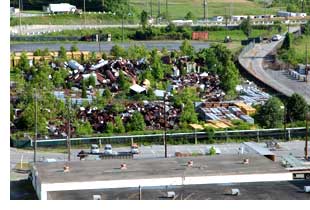Salvage Yard:
 Salvage
yards, otherwise known as scrap yards and junkyards, are most commonly used for salvaging a variety of scrap metal, including
appliances, automobiles, railroad cars, and government surplus vehicles. However, some salvage yards will contain other items
such as furniture, tires, batteries, and have been known to accept electric transformers and drums from industrial waste in the
past.
Salvage
yards, otherwise known as scrap yards and junkyards, are most commonly used for salvaging a variety of scrap metal, including
appliances, automobiles, railroad cars, and government surplus vehicles. However, some salvage yards will contain other items
such as furniture, tires, batteries, and have been known to accept electric transformers and drums from industrial waste in the
past.Accidental spills and releases of vehicle fluids are the most common cause of environmental damage found at automobile salvage yards. Spills can occur if fluids are left in the vehicle when stored in the yard, when the fluids are intentionally removed from the vehicle, and when fluids are transferred into or out of storage containers and tanks.
Potential impacts from salvage yards may arise from storm water runoff discharges. Organic compounds that are present in petroleum products such as oil and gasoline are not only chemically toxic to aquatic life and humans, but also deplete oxygen in surface waters due to their biodegradability, further impacting aquatic life and water quality. When rain or flooding occurs, pollutants can be washed from the salvage yards and carried onto abutting properties and into rivers, streams, and lakes. The resources listed below contain many pollution prevention strategies and best management practices for salvage yards.
Contaminants of Concern:
Some inorganic and organic contaminants typically associated with the operation of a salvage yard can reasonably include:- Volatile organic compounds (from gasoline): benzene, ethylbenzene, toluene, and xylene
- Volatile organic compounds (from degreasing): solvents
- Other organic compounds (from cars): greases, oils, plastics, and rubber
- Other inorganic compounds (from cars and scrap metals): chromium, copper, iron, lead, nickel, and zinc
Many of these contaminants are known to have toxic effects, both carcinogenic and non-carcinogenic, and the metals and VOCs are highly mobile.
Some salvage yards have been known to take drums of industrial waste in the past and may contain such materials as waste industrial solvents, tar, and iron cakes, sludges, transformer oil, pesticides, herbicides, paints, and inks. Drums may have been emptied on to the ground, burned on the active parts of some salvage yards, or may be buried onsite.
Implementing Solutions:
Please submit your experiences (successes/challenges) and tribal-specific documents to share on our website using the attached form.Download Form
Resources:
Colorado Department of Public Health and Environment: Automotive Salvage Yard Waste Management Practices in Colorado [pdf]Broward County Board of County Commissioners Environmental Protection and Growth Management Department: Pollution Prevention and Best Management Practices for Automobile and Other Salvage Facilities [pdf]
EPA Superfund Record of Decision for Van Dale Junkyard [pdf]
Agency of Natural Resource Department of Environmental Conservation Compliance and Enforcement Division Report on the Regulation of Salvage Yards [pdf]
Related Pages:
Hazardous Substance ResponseOil Spill Response
Superfund CERCLA
RCRA
For more information, please contact:
Jennifer Williams, Alaska Program Coordinator, Sr.
Tel: 928/523-0673
Email: Jennifer.Williams@nau.edu
Tel: 928/523-0673
Email: Jennifer.Williams@nau.edu
Last updated: July 10, 2015
